Crohn's Disease: Radiological Answers to Clinical Questions and Review of the Literature
- PMID: 39064186
- PMCID: PMC11277847
- DOI: 10.3390/jcm13144145
Crohn's Disease: Radiological Answers to Clinical Questions and Review of the Literature
Abstract
Background: Crohn's disease (CD) is a chronic, progressive inflammatory condition, involving primarily the bowel, characterized by a typical remitting-relapsing pattern. Despite endoscopy representing the reference standard for the diagnosis and assessment of disease activity, radiological imaging has a key role, providing information about mural and extra-visceral involvement. Methods: Computed Tomography and Magnetic Resonance Imaging are the most frequently used radiological techniques in clinical practice for both the diagnosis and staging of CD involving the small bowel in non-urgent settings. The contribution of imaging in the management of CD is reported on by answering the following practical questions: (1) What is the best technique for the assessment of small bowel CD? (2) Is imaging a good option to assess colonic disease? (3) Which disease pattern is present: inflammatory, fibrotic or fistulizing? (4) Is it possible to identify the presence of strictures and to discriminate inflammatory from fibrotic ones? (5) How does imaging help in defining disease extension and localization? (6) Can imaging assess disease activity? (7) Is it possible to evaluate post-operative recurrence? Results: Imaging is suitable for assessing disease activity, extension and characterizing disease patterns. CT and MRI can both answer the abovementioned questions, but MRI has a greater sensitivity and specificity for assessing disease activity and does not use ionizing radiation. Conclusions: Radiologists are essential healthcare professionals to be involved in multidisciplinary teams for the management of CD patients to obtain the necessary answers for clinically relevant questions.
Keywords: Computed Tomography; Crohn’s disease; Magnetic Resonance Imaging; inflammatory bowel disease.
Conflict of interest statement
The authors declare no conflict of interest.
Figures
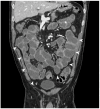




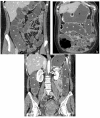






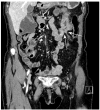

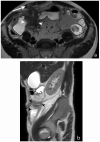
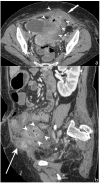




Similar articles
-
Magnetic resonance enterography compared with ultrasonography in newly diagnosed and relapsing Crohn's disease patients: the METRIC diagnostic accuracy study.Health Technol Assess. 2019 Aug;23(42):1-162. doi: 10.3310/hta23420. Health Technol Assess. 2019. PMID: 31432777 Free PMC article. Clinical Trial.
-
Visceral adiposity and inflammatory bowel disease.Int J Colorectal Dis. 2021 Nov;36(11):2305-2319. doi: 10.1007/s00384-021-03968-w. Epub 2021 Jun 9. Int J Colorectal Dis. 2021. PMID: 34104989 Review.
-
A comprehensive review and update on Crohn's disease.Dis Mon. 2018 Feb;64(2):20-57. doi: 10.1016/j.disamonth.2017.07.001. Epub 2017 Aug 18. Dis Mon. 2018. PMID: 28826742 Review.
-
Magnetic resonance enterography in Crohn's disease: a guide to common imaging manifestations for the IBD physician.J Crohns Colitis. 2013 Sep;7(8):603-15. doi: 10.1016/j.crohns.2012.10.005. Epub 2012 Nov 1. J Crohns Colitis. 2013. PMID: 23122965 Review.
-
Multimodality imaging features of small bowel cancers complicating Crohn's disease: a pictorial review.Abdom Radiol (NY). 2024 Jun;49(6):2083-2097. doi: 10.1007/s00261-024-04201-2. Epub 2024 Mar 5. Abdom Radiol (NY). 2024. PMID: 38441632 Review.
References
-
- Maaser C., Sturm A., Vavricka S.R., Kucharzik T., Fiorino G., Annese V., Calabrese E., Baumgart D.C., Bettenworth D., Borralho Nunes P., et al. ECCO-ESGAR Guideline for Diagnostic Assessment in IBD Part 1: Initial Diagnosis, Monitoring of Known IBD, Detection of Complications. J. Crohns Colitis. 2019;13:144–164. doi: 10.1093/ecco-jcc/jjy113. - DOI - PubMed
Publication types
Grants and funding
LinkOut - more resources
Full Text Sources

